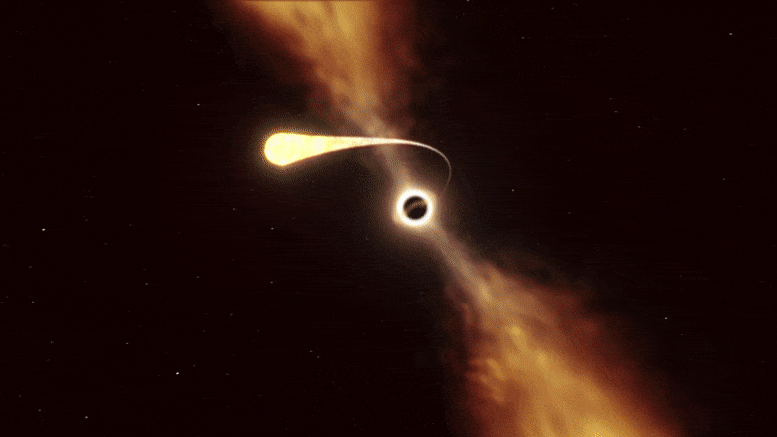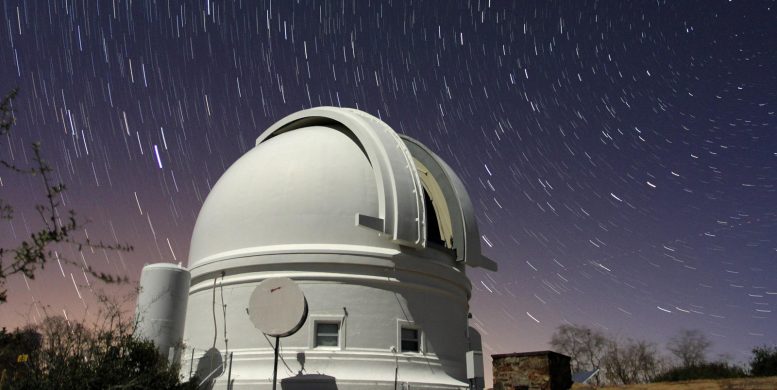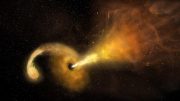
This animation depicts a star experiencing spaghettification as it’s sucked in by a supermassive black hole during a ‘tidal disruption event’. In a new study, done with the help of ESO’s Very Large Telescope and ESO’s New Technology Telescope, a team of astronomers found that when a black hole devours a star, it can launch a powerful blast of material outwards. Credit: ESO/M. Kornmesser
Astronomers have determined the source of an incredibly bright X-ray, optical, and radio signal appearing from halfway across the Universe.
Named AT 2022cmc, the signal was discovered earlier this year by the Zwicky Transient Facility in California. Findings published today (November 30) in Nature Astronomy, suggest that it is likely from a jet of matter, streaking out from a supermassive black hole at close to the speed of light.
The team, including researchers from MIT and the University of Birmingham, believe the jet is the product of a black hole that suddenly began devouring a nearby star, releasing a huge amount of energy in the process. Their findings could shed new light on how supermassive black holes feed and grow.

The Zwicky Transient Facility scans the sky using a state-of-the-art wide-field camera mounted on the Samuel Oschin telescope at the Palomar Observatory in Southern California. Credit: Palomar Observatory/Caltech
Astronomers have observed other such “tidal disruption events,” or TDEs, in which a passing star is torn apart by a black hole’s tidal forces. However, AT 2022cmc is brighter than any TDE discovered to date, and, at some 8.5 billion light years away, is also the farthest TDE ever detected.
The team measured the distance to the AT 2022cmc using the European Southern Observatory’s Very Large Telescope, in Chile.
Dr. Matt Nicholl, associate professor at the University of Birmingham, said: “Our spectrum told us that the source was hot: around 30,000 degrees, which is typical for a TDE. But we also saw some absorption of light by the galaxy where this event occurred. These absorption lines were highly shifted towards redder wavelengths, telling us that this galaxy was much further away than we expected!”

The Very Large Telescope, or VLT, at the Paranal Observatory in Chile’s Atacama Desert. Credit: A. Ghizzi Panizza/ESO
How could such a distant event appear so bright in our sky? The team says the black hole’s jet may be pointing directly toward Earth, making the signal appear brighter than if the jet were pointing in any other direction. The effect is “Doppler boosting,” and is similar to the amped-up sound of a passing siren.
AT 2022cmc is the fourth Doppler-boosted TDE ever detected and the first such event that has been observed since 2011. It is also the first boosted TDE discovered using an optical sky survey. As more powerful telescopes start-up in the coming years, they will reveal more TDEs, which can shed light on how supermassive black holes grow and shape the galaxies around them.
Following AT 2022cmc’s initial discovery, the team focused in on the signal using the Neutron star Interior Composition ExploreR (NICER), an X-ray telescope that operates aboard the International Space Station.

NASA’s Neutron star Interior Composition Explorer (NICER), at center, is an X-ray telescope aboard the International Space Station. Credit: NASA
“Things looked pretty normal the first three days,” recalls Dheeraj “DJ” Pasham, who was first author on the study. “Then we looked at it with an X-ray telescope, and what we found was, the source was 100 times more powerful than the most powerful gamma-ray burst afterglow.”
Typically, such bright flashes in the sky are gamma-ray bursts — extreme jets of X-ray emissions that spew from the collapse of massive stars.
Dr. Benjamin Gompertz, assistant professor at the University of Birmingham, led the gamma-ray burst comparison analysis. “Gamma-ray bursts are the usual suspects for events like this,” he said. “However, as bright as they are, there is only so much light a collapsing star can produce. Because AT 2022cmc was so bright and lasted so long, we knew that something truly gargantuan must be powering it – a supermassive black hole.”
The extreme X-ray activity is believed to be powered by an “extreme accretion episode” when the shredded star creates a whirlpool of debris as it falls into the black hole. Indeed, the team found that AT 2022cmc’s X-ray luminosity was comparable to, though brighter than, three previously detected TDEs.
“It’s probably swallowing the star at the rate of half the mass of the sun per year,” Pasham estimates. “A lot of this tidal disruption happens early on, and we were able to catch this event right at the beginning, within one week of the black hole starting to feed on the star.”
“We expect many more of these TDEs in the future,” co-author Matteo Lucchini adds. “Then we might be able to say, finally, how exactly black holes launch these extremely powerful jets.”
Reference: “The birth of a relativistic jet following the disruption of a star by a cosmological black hole” by Dheeraj R. Pasham, Matteo Lucchini, Tanmoy Laskar, Benjamin P. Gompertz, Shubham Srivastav, Matt Nicholl, Stephen J. Smartt, James C. A. Miller-Jones, Kate D. Alexander, Rob Fender, Graham P. Smith, M. Fulton, Gulab Dewangan, Keith Gendreau, Eric R. Coughlin, Lauren Rhodes, Assaf Horesh, Sjoert van Velzen, Itai Sfaradi, Muryel Guolo, Noel Castro Segura, Aysha Aamer, Joseph P. Anderson, Iair Arcavi, Seán J. Brennan, Kenneth Chambers, Panos Charalampopoulos, Ting-Wan Chen, A. Clocchiatti, Thomas de Boer, Michel Dennefeld, Elizabeth Ferrara, Lluís Galbany, Hua Gao, James H. Gillanders, Adelle Goodwin, Mariusz Gromadzki, M. Huber, Peter G. Jonker, Manasvita Joshi, Erin Kara, Thomas L. Killestein, Peter Kosec, Daniel Kocevski, Giorgos Leloudas, Chien-Cheng Lin, Raffaella Margutti, Seppo Mattila, Thomas Moore, Tomás Müller-Bravo, Chow-Choong Ngeow, Samantha Oates, Francesca Onori, Yen-Chen Pan, Miguel Perez-Torres, Priyanka Rani, Ronald Remillard, Evan J. Ridley, Steve Schulze, Xinyue Sheng, Luke Shingles, Ken W. Smith, James F. Steiner, Richard Wainscoat, Thomas Wevers and Sheng Yang, 30 November 2022, Nature Astronomy.
DOI: 10.1038/s41550-022-01820-x
Other Birmingham scientists who contributed to this paper were Dr. Graham Smith, Dr. Samantha Oates, and PhD researchers Aysha Aamer, Evan Ridley, and Xinyue Sheng.









A master race’s transuniversal mining method may involve the designed breakdown of certain stars to fuel their energy needs, using what is called “starvesting” to gather solar energy and transmit the energized product to their home galaxy where is can support their vast need for energy. It has been discovered that some of the stars that they are harvesting are universal markers which naturally regulate the rates of local universal expansion and diminutation (shrinking). There is a great conflict in their galaxy between the energy collection concerns, and the groups of concerned scientists who have demonstrated that the breakdown of these key stars may cause simultaneous diminutation and expansion of the quadrants where these stars are being destroyed. The end product of this activity might possibly be the equivalent of what is referred to as a “hurricane” on Earth, but a 3 dimensional one that is ever expanding and contracting, and this may rip the universe apart in these areas, and in time is predicted to cause a major breakdown of stability right across eternity. This mining method involves using robotic scanners that comb the universe for the type of stars needed to support their operations, and the fact that some suns have been starvested in our galaxy may mean that we need to make contact with this civilization to make a plea for them to move their operations to a safe distance on the other side of our galaxy, or to a different one for the sake of our solar system and our continued survival in this galaxy.
Your comment was intriguing enough to read through, but lacked the proper grammatical paragraph-spacing to take seriously.
I however have no doubt you carry some level of merit in some knowledge.
So are we being “mooned”!?!